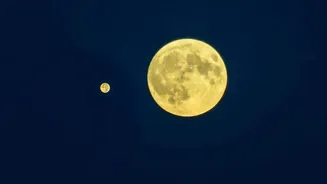Lemmon's Grand Arrival
Comet C/2025 A6 (Lemmon) is anticipated to make its appearance in the October sky, drawing the attention of stargazers and astrophotographers alike. The
anticipation builds around whether it will be visible to the naked eye, offering an accessible celestial spectacle for everyone. This comet's arrival is not just a visual treat; it also allows scientists to gain insights into the formation and evolution of our solar system. The comet's journey offers a unique opportunity to witness a celestial body up close, providing a deeper understanding of the universe's vastness. With the possibility of a bright showing, many are preparing their telescopes and cameras to capture its beauty and study its composition, hoping to unveil new secrets about space.
Spotting Comet Lemmon
Finding Comet Lemmon involves understanding its trajectory and knowing when to look. The first step involves checking astronomical resources or apps that provide the comet's precise coordinates in the sky. These tools offer up-to-date information on the comet's position, helping viewers locate it against the backdrop of stars. Light pollution is a major hurdle; therefore, to increase the chances of spotting Lemmon, find a location away from city lights, where the night sky is darker. Once you're at the ideal observing location, allow your eyes to adjust to the darkness for about 20-30 minutes, this will improve your ability to see faint objects. With patience and persistence, Comet Lemmon is likely to provide a captivating experience for all who are ready to observe the comet.
Photographing the Comet
Photographing Comet Lemmon requires a bit of planning and the right equipment, but the result can be a stunning image of the celestial visitor. A DSLR camera, a telescope, or a telephoto lens is essential. Begin by attaching your camera to a sturdy tripod to avoid blurry images due to movement. Choose a location far from light pollution for a clear view of the comet. Experiment with camera settings, such as ISO, aperture, and exposure time. A high ISO can capture the comet's faint light, while a wide aperture and longer exposure time allow more light to hit the camera sensor. Start with short exposures and gradually increase the exposure time. Take multiple shots and stack them to create a combined image, which allows for improved details and reduces noise. Post-processing software is useful for enhancing the comet's features and removing unwanted artifacts. With careful planning and attention to detail, you can capture breathtaking photos of Comet Lemmon.
Lemmon's Celestial Dance
Comet Lemmon's approach to Earth in October creates a unique opportunity to see it up close. Comet Lemmon will have its closest approach to Earth on October 24. As the comet gets closer to the sun, it will heat up, causing its ice to vaporize and form a tail. As the comet approaches its closest point to Earth, this celestial ballet is a sight to behold. Observing this event allows us to understand the comet's behavior, changes in its structure, and the resulting gas and dust from the sublimation of ice, all of which contribute to our broader knowledge of space. Observing and photographing this celestial dance will offer a visual feast and boost our understanding of the solar system's origins and the intricate processes that shape these icy wanderers.
Other October Wonders
While Comet Lemmon is the main attraction, October's night sky offers other wonders for astronomy enthusiasts. The Orionid meteor shower, an annual event, lights up the sky with bright streaks. Observing this shower enhances the celestial viewing experience. Comet C/2025 R2 (SWAN) is another potential target, with opportunities to see it shine during the month. Viewing these events requires an awareness of their peak times. It's a great time to explore the night sky for these fleeting streaks of light. Beyond these events, there may be chances to witness other celestial objects and events like the position of the planets and the lunar phases. October provides a packed and enriching experience for skywatchers.












